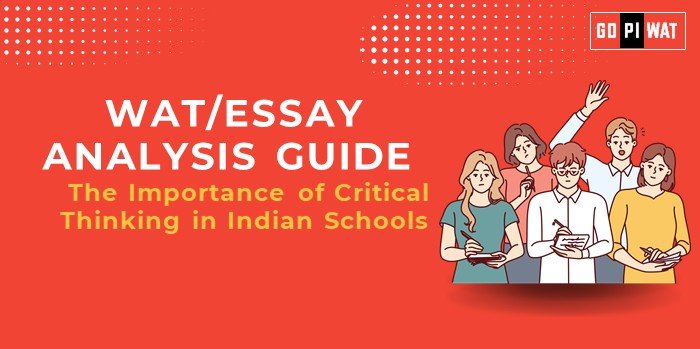📋 The Importance of Critical Thinking in Indian Schools
🌐 WAT/Essay Analysis Guide
💡 Understanding Critical Thinking’s Importance
Context: As globalization reshapes the economy, critical thinking becomes essential for a workforce capable of innovation and adaptability. Integrating critical thinking into Indian schools bridges the gap between academic knowledge and practical application, ensuring students are future-ready.
⏳ Effective Planning and Writing
- 🕒 Time Allocation:
- 📝 Planning: 5 minutes
- ✍️ Writing: 20 minutes
- 🔍 Review: 5 minutes
- 📋 Preparation Tips:
- 📊 Focus on data-backed arguments and real-world examples.
- 💡 Highlight challenges and propose feasible solutions.
💬 Introduction Techniques for Essays
- ⚖️ Contrast Approach: “Despite being the world’s second-largest education system, India struggles to foster critical thinking among students—a skill vital for 21st-century jobs.”
- 🔧 Solution-Based Approach: “Critical thinking, the foundation of innovation, requires India’s education system to shift focus from rote learning to analytical skills.”
- ⏳ Timeline Approach: “While NEP 2020 laid the groundwork for fostering critical thinking, much remains to be done to achieve transformative outcomes.”
📊 Structuring the Essay Body
🏆 Achievements:
- 📜 NEP 2020: Introduced experiential learning and a shift away from rote memorization.
- 🌟 Project-Based Learning: Delhi schools implemented project-based approaches to encourage problem-solving and creativity.
- 💻 EdTech Platforms: Tools like BYJU’s and Google Classroom foster interactive learning and critical analysis.
⚠️ Challenges with Comparative Analysis:
- 🏫 Resource Disparities: While Finland ensures equal access to education for all, India faces significant urban-rural gaps in resources and opportunities.
- 👩🏫 Teacher Training Gaps: In contrast to Singapore’s robust professional development programs, Indian teachers often lack training to nurture critical thinking skills.
- 🌐 Outdated Curriculum: The focus on high-stakes testing discourages innovation and critical thought.
🚀 Future Outlook:
- 🎮 Gamified Learning: Use interactive tools and AI-powered platforms to encourage critical thinking in classrooms.
- 🌍 International Collaborations: Adopt best practices from countries like Finland and Singapore for curriculum and teacher training.
- 👩🏫 Robust Teacher Training: Establish programs focused on nurturing analytical skills and experiential learning methods.
✅ Concluding Effectively
- ⚖️ Balanced Perspective: “Critical thinking is crucial for India’s educational evolution, but its success depends on addressing systemic gaps in training, infrastructure, and implementation.”
- 🌍 Global Comparison: “Learning from Finland’s equal-access model and Singapore’s skills-based education can guide India in fostering critical thinking universally.”
📊 Analyzing Successes and Shortcomings
- ✨ Achievements:
- 📜 Policy frameworks like NEP 2020 emphasize critical thinking and skill-based learning.
- 💻 Innovations in EdTech foster interactive and analytical learning.
- ⚠️ Ongoing Challenges:
- 🌐 Persistent digital divide and resource disparities between urban and rural areas.
- 👩🏫 Lack of teacher training to facilitate critical thinking in classrooms.
- 🌍 Global Context:
- 🇸🇬 Singapore: A focus on problem-solving and professional teacher training ensures critical thinking is embedded in education.
- 🇫🇮 Finland: Equal access to high-quality education fosters critical and creative thinking across all student demographics.
💡 Recommendations for Sustainable Progress
- 👩🏫 Invest in Teacher Training: Focus on programs that nurture analytical teaching methods and problem-solving skills.
- 💻 Leverage Technology: Use EdTech platforms to deliver interactive, critical thinking-focused learning experiences.
- 🏫 Bridge Urban-Rural Divides: Implement phased strategies to ensure critical thinking opportunities for all students.
📝 Sample Short Essays
🔹 Balanced Perspective:
“India’s education system stands at a crossroads where integrating critical thinking is vital for future success. Despite policy frameworks like NEP 2020, resource disparities pose challenges that require phased, inclusive approaches.”
🔹 Solution-Oriented:
“By investing in teacher training and leveraging EdTech tools, India can ensure critical thinking becomes a cornerstone of its education system, preparing students for a globalized economy.”
🔹 Global Comparison:
“Adopting Finland’s equal-access model and Singapore’s problem-solving approach can accelerate India’s journey toward a critical thinking-oriented education system, fostering innovation and adaptability.”


